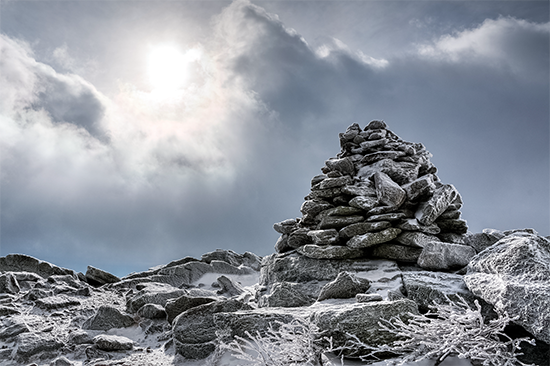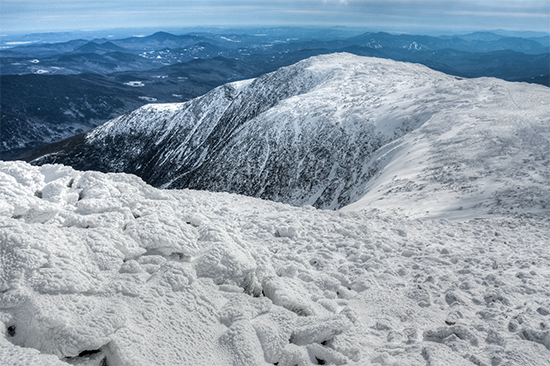
August-
September 2022
Give Me That Mountain!
------------------
|





Watch for the Cairns
By Brenda J. Evans
After the last yellow arrow, keep left and once you crest the headwall, follow the cairns to the top of the mountain. Pay attention. There may be whiteouts with no clear path. Watch for the cairns. It’s easy to take a wrong turn.
I know about wrong turns. I’ve taken a few, though not in Tuckerman Ravine on Mount Washington in northern New Hampshire.
Keep left once you crest the headwall. I wonder what a headwall is, so I google it: a steep cliff at the uppermost part of a cirque. A cirque? Google that, too: a bowl-shaped area like an amphitheater sculpted out of mountain terrain by glacial erosion. So many things to watch for!
So, if you are like I am, stay off Tuckerman Ravine’s 7.4-mile trail with its cirque and headwall and cairns and take the cog railroad to the Mt. Washington summit. Sure, you’ll choke half to death on the gritty black soot from the coal-fired steam locomotive, but you’ll live and arrive at the summit with no worry about headwalls, cirques, and wrong turns. (Plus, you’ll get there hours before your feet would have taken you through the ravine.)
You could take the “drive-yourself” auto road that climbs to the summit at a gradient of 11.6 percent. That’s dicey, too—mostly one lane, part asphalt, part gravel. I stick with the cog railroad. At the top, take off your hat, or it will blow away while you gaze north to Canada and west to Vermont.
Mt. Washington, the premier peak of the Presidential Range in the White Mountains of New Hampshire, rises to 6,288 feet, highest in the Northeastern U.S. Thirteen prominent mountains rise in the range, five named after the first five U.S. presidents: Washington, Adams, Jefferson, Madison, Monroe.
Mt. Washington is the most prominent and the most notorious, especially for wind. In April 1934, meteorologists recorded a surface wind speed of 231 mph, still the world record for winds not associated with tornados and cyclones. Any summer day, wind speeds range between 25 mph and 125 mph—or more. Hold on to your hat! Better yet, poke it into your backpack. Washington is also famous for fog, clouds, and heavy snow at an average of 280 inches per year and a record 566 inches the winter of 1968-69. Mt. Washington takes lives and instills fear but rouses joy, too.
Say you are hardier than I am and decide to hike the “Tucks” as climbers call Tuckerman Ravine Trail. Be prepared, pay attention, and follow the cairns. And, by all means, get a Tucks weather forecast, slip micro-spikes over your hiking boots for traction on packed ice, and use a trekking pole with a disk-shaped “snow basket” to keep your pole from sinking in soft snow—if any is soft. Above all, follow the cairns—your trustworthy markers up the mountain.

A cairn is a man-made stack of stones and comes from a Scottish Gaelic word meaning heap of stones. Cairns are ancient structures, both Christian and pagan. They mark boundaries, burial sites, navigational points, ceremonial grounds, and places of worship. Some are inukshuks shaped like human figures.
It also pays to watch for cairns in our walk of life with its hills and valleys “under the sun,” as Solomon described it. The Christian life is a trek. Sometimes easy, straight, and enjoyable. Sometimes slippery and treacherous—a fight with elements in unknown territories. Who knows what’s ahead on the psalmist’s way everlasting (139:24), or Jeremiah’s ancient path “where the good way is” (6:16).
When the winds howl and are hostile, when the “wicked prowl” on every side (Psalm 12:8), we watch for cairns marking the way. Old Testament stories teem with towers of rocks that mark God’s help and might, His guidance and salvation, even His judgment.
Joshua built cairns. At the Jordan, he told 12 men, one from each tribe, to hoist a stone from the middle of the river and bring it into Canaan. At Gilgal, they dropped the 12 stones into a heap. A cairn, 12 stones of remembrance, gratitude, and praise.
Joshua explained: “When your children ask what the stones mean in the coming years, tell them Israel passed over Jordan on dry ground, that the hand of the Lord is mighty” (Joshua 4). Watch for cairns that remind you of the Lord’s might, His hand that dries up rivers, holds back floods, leads you down a good path on the way everlasting. Voice your gratitude. Say aloud what the cairn means and has always meant on your trek. Tell your children and grandchildren, friends, and fellow believers. Declare what those “stacks of stones” in your life mean about God’s faithfulness.
Before long, Joshua and the people raised another—and this time awful—cairn. The Lord brought trouble on Israel and on Achan for his greed and thievery at Jericho. Israel lost the battle for Ai. Joshua questioned Achan and, at God’s command, Israel stoned him for his theft. They also stoned and burned his family, his animals, the items he stole—everything he had. By the time they finished, they had created “a great heap of stones” in the Valley of Achor, or valley of trouble (Joshua 7).
Watch for cairns marking times and places of sin and consequential punishment. These cairns remind us sin is not an insignificant pebble tossed into a placid pond, but a boulder that splashes into our lives creating waves of turbulence that damage and defile us and hinder others.
Samuel raised just one cairn, as far as we know. He named it Ebenezer after Israel defeated the Philistines. “Till now the Lord has helped us,” he said. Ebenezer, the stone of help. Watch for it.
Other cairns mark squabbles, disagreements, and quarrels similar to Laban and Jacob’s pile of rocks in Genesis 31. Laban told Jacob those stones would serve as a witness
between them, a marker of an uneasy truce (31:48). Twenty years of bad blood had blackened their relationship, with distrust, accusations, deceptions, and quarrels on both sides. No heroes here. Both were contentious, deceptive, and divisive. Both made excuses and mouthed denials.
As for the stones between them, the cairn hardly meant all was well. It merely created a boundary marker symbolizing their pledge to stay out of each other’s hair, not to cross over and do harm. Laban described it as “a witness” with God guarding the boundary, the judge of the one who stepped over the line. Hardly a blessing!
Laban called on his pagan household gods. Jacob pointed to “the God of my father, the God of Abraham and the fear of Isaac.”
Perhaps this boundary cairn became a sign of reconciliation and peace between the two, because Laban is never mentioned again in Genesis. In any case, cairns like these call God’s people to bury the past, rise above animosities, shed contempt and accusations, forgive, and pour oil on troubled waters. To throw no more stones into a tranquil pond, creating angry waves that spread damage and hurt.
So, as we go, watch for the cairns on the ancient path “where the good way is.” And, may we also gather stones of remembrance and build cairns of gratitude, praise, and encouragement to point our children and their children toward the Way Everlasting.
About the Author: Brenda Evans lives and writes in Ashland, Kentucky. You may contact her at beejayevans@windstream.net.
|
|

